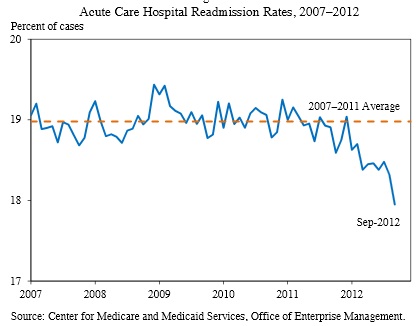Hospital readmissions
Editor-In-Chief: C. Michael Gibson, M.S., M.D. [1]
Overview
Hospital readmission is the unplanned readmission for any cause to any acute care hospital within a certain period of time following the discharge from a hospitalization. Centers for Medicare & Medicaid Services (CMS) choose to measure unplanned readmission within 30 days instead of over longer time periods (such as 90 days), because readmissions over longer periods may be impacted by factors outside hospitals’ control such as other complicating illnesses, patients’ own behavior, or care provided to patients after discharge.
Epidemiology
Among Medicare patients in the United States receiving care in a fee-for-service setting during 2003-2004, 19.6% were rehospitalized within 30 days.[1]
Shown below is an image depicting the Medicare readmission rate in 2013.

Causes
In a study of Medicare patients in the United States, most of the variation in rates of readmission are due to characteristics of patients.[2] A much smaller degree of variation is due to characteristics of hospitals or health care providers.[2]
A systematic review found that approximately 25% of readmissions are avoidable; however, rates varied widely among individual studies included within the review.[3]
Costs
Prediction
A number of methods have been developed to predict which patients will be readmitted.[4] Two or more hospitalizations within a year is a simple predictor of readmission.[5] A study of adult patients in the University of Pennsylvania Health System found that ≥ 2 inpatient admissions in the past 12 months had a sensitivity and specificity of 39% and 84%, respectively, for predicting readmission. In populations similar to those in this study which had a prevalence of hospital readmission of 15%, the probabilities of hospital readmission among patients with and without ≥ 2 inpatient admissions in the past 12 months were 30.0% and 11.0%, respectively.[5] Click here to estimate predictive values in populations with different rates of readmission. A second study reported sensitivity and specificity of 25% and 78%, respectively.[6]
Prevention
A meta-analysis of 42 randomized controlled trials found “interventions are effective at reducing readmissions, but more effective interventions are complex and support patient capacity for self-care.”[7] This review also reported that more recent trials showed less impact. Accordingly, two more recent trials were negative, but both had strong interventions in the control group. In one of the trials, a virtual ward reduced admissions by 4%, but this was not statistically significant.[8] Another subsequent trial show an insignificant increase in readmissions or emergency department visits in the intervention group.[9]
Regarding medication reconciliations, a meta-analysis by the Cochrane Collaboration found no clear benefit.[10]
Regarding telephone calls to patients after discharge, detailed, scripted phone calls may be effective.[11][12]
References
- ↑ Jencks SF, Williams MV, Coleman EA (2009). "Rehospitalizations among patients in the Medicare fee-for-service program". N Engl J Med. 360 (14): 1418–28. doi:10.1056/NEJMsa0803563. PMID 19339721.
- ↑ 2.0 2.1 Singh S, Lin YL, Kuo YF, Nattinger AB, Goodwin JS (2014). "Variation in the risk of readmission among hospitals: the relative contribution of patient, hospital and inpatient provider characteristics". J Gen Intern Med. 29 (4): 572–8. doi:10.1007/s11606-013-2723-7. PMC 3965757. PMID 24307260.
- ↑ van Walraven C, Bennett C, Jennings A, Austin PC, Forster AJ (2011). "Proportion of hospital readmissions deemed avoidable: a systematic review". CMAJ. 183 (7): E391–402. doi:10.1503/cmaj.101860. PMC 3080556. PMID 21444623.
- ↑ Kansagara D, Englander H, Salanitro A, Kagen D, Theobald C, Freeman M; et al. (2011). "Risk prediction models for hospital readmission: a systematic review". JAMA. 306 (15): 1688–98. doi:10.1001/jama.2011.1515. PMC 3603349. PMID 22009101.
- ↑ 5.0 5.1 Baillie CA, VanZandbergen C, Tait G, Hanish A, Leas B, French B; et al. (2013). "The readmission risk flag: using the electronic health record to automatically identify patients at risk for 30-day readmission". J Hosp Med. 8 (12): 689–95. doi:10.1002/jhm.2106. PMID 24227707.
- ↑ Hasan O, Meltzer DO, Shaykevich SA, Bell CM, Kaboli PJ, Auerbach AD; et al. (2010). "Hospital readmission in general medicine patients: a prediction model". J Gen Intern Med. 25 (3): 211–9. doi:10.1007/s11606-009-1196-1. PMC 2839332. PMID 20013068.
- ↑ Leppin AL, Gionfriddo MR, Kessler M, Brito JP, Mair FS, Gallacher K; et al. (2014). "Preventing 30-day hospital readmissions: a systematic review and meta-analysis of randomized trials". JAMA Intern Med. 174 (7): 1095–107. doi:10.1001/jamainternmed.2014.1608. PMID 24820131.
- ↑ Dhalla IA, O'Brien T, Morra D, Thorpe KE, Wong BM, Mehta R; et al. (2014). "Effect of a postdischarge virtual ward on readmission or death for high-risk patients: a randomized clinical trial". JAMA. 312 (13): 1305–12. doi:10.1001/jama.2014.11492. PMID 25268437.
- ↑ Goldman LE, Sarkar U, Kessell E, Guzman D, Schneidermann M, Pierluissi E; et al. (2014). "Support from hospital to home for elders: a randomized trial". Ann Intern Med. 161 (7): 472–81. doi:10.7326/M14-0094. PMID 25285540.
- ↑ Christensen M, Lundh A (2013). "Medication review in hospitalised patients to reduce morbidity and mortality". Cochrane Database Syst Rev. 2: CD008986. doi:10.1002/14651858.CD008986.pub2. PMID 23450593.
- ↑ Oduyebo I, Lehmann CU, Pollack CE, Durkin N, Miller JD, Mandell S; et al. (2013). "Association of self-reported hospital discharge handoffs with 30-day readmissions". JAMA Intern Med. 173 (8): 624–9. doi:10.1001/jamainternmed.2013.3746. PMC 3692004. PMID 23529278.
- ↑ Melton LD, Foreman C, Scott E, McGinnis M, Cousins M (2012). "Prioritized post-discharge telephonic outreach reduces hospital readmissions for select high-risk patients". Am J Manag Care. 18 (12): 838–44. PMID 23286612.